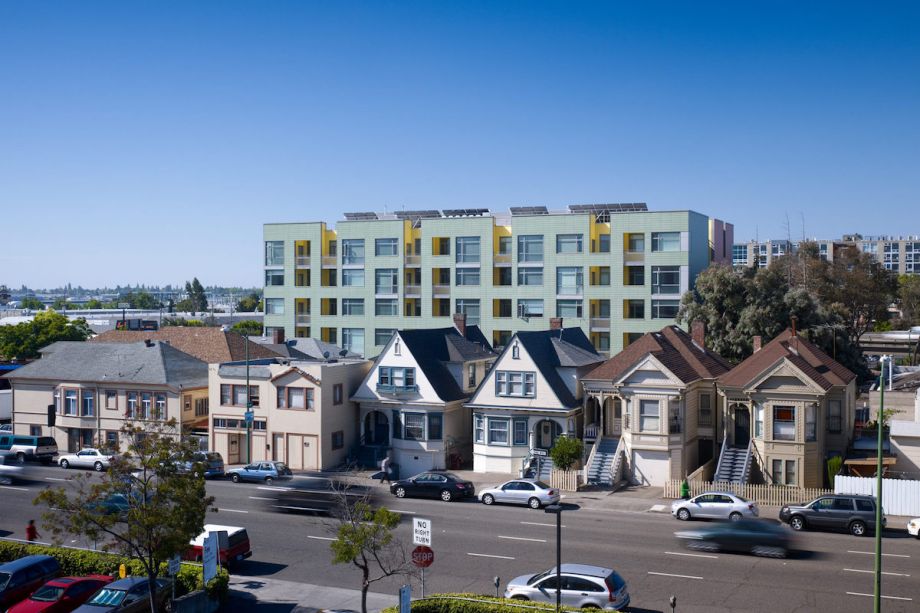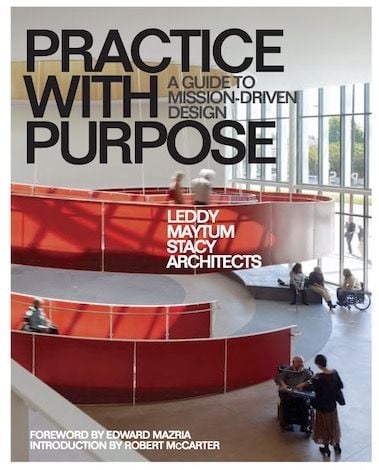
(Photo by Tim Griffith)
This is an adapted excerpt from “Practice with Purpose: A Guide to Mission-Driven Design” by Bill Leddy, FAIA, Principal at Leddy Maytum Stacy Architects and the firm’s team. It is republished with permission.
The U.S. housing crisis has been widely discussed for decades, with recent studies confirming that it is escalating and impacting Americans at nearly all income levels. During the COVID pandemic, home prices increased sharply nationwide while average incomes dropped.

In California the annual average household income required to rent a two-bedroom dwelling is $81,191. Tragically, 1.2 million households in the state, or 21% of the population, have an annual income of $27,330 or less. Nationwide, there are an estimated 580,000 unhoused individuals, of which more than 200,000 are unsheltered, living on the streets of one of the wealthiest nations on earth.
Statistics tell only part of the story. Perhaps a more relatable perspective is to see the housing crisis for what it really is: a profound public health crisis. The Network for Public Health Law reports that “housing instability…causes and exacerbates health problems, erodes communities, and drives health inequities… Those who lack stable housing are more likely to experience homelessness, unemployment, substance use, food insecurity, and violence.”
Access to safe, healthy, dignified housing has long been considered fundamental human equity and was formally recognized in 1948 by the United Nations in the Universal Declaration of Human Rights. Nearly two decades later, this nonbinding declaration was codified into a binding treaty in the 1966 International Covenant on Economic, Social and Cultural Rights. The U.S. signed that treaty but still has not ratified it. In 1999, the Faircloth Amendment to the 1937 U.S. Housing Act prohibited all new federally funded public housing except for one-for-one replacement, reversing years of housing benefits. Since then, state and local public housing agencies and nonprofit affordable housing developers have formed public-private partnerships in many cities to patch together complex funding models that allow some affordable housing development to continue.
Architecture has an important role to play in addressing the housing crisis. Well-designed affordable housing is just as critical to the health and vitality of our communities as any other building type. It deserves the same creativity and devotion from architects as any museum, library, or school. Here are some strategies to consider.
Community
Affordable housing can build strong, equitable communities within its walls and out in its neighborhood. Their entries should be transparent, welcoming everyone with dignity and respect. Including generous community rooms, garden courts, and supportive service spaces will invite residents to gather, linger, and socialize. The buildings themselves can both contribute to and symbolize an inclusive, diverse community.
Economy
The design of affordable housing requires working within limited budgets, leveraging every design move to yield multiple practical and aesthetic benefits. Individual units need to be simple and compact, but when they are assembled creatively — like a three-dimensional puzzle rather than a one-dimensional box — they can add interest to the building massing. Efficient, double-loaded corridors can be reimagined by adding daylight, celebrating unit entries, and treating them as community gathering spaces. Economical, durable finishes can be elevated through careful articulation, and special features or finishes can be used in communal spaces for the greatest impact.
Health
Healthy indoor air quality, abundant daylight, connections to nature, on-site access to job training and counseling: these are all important strategies that support individuals who may need time to heal. But perhaps an even more important contributor to their well-being is the sense of security, hope, and dignity that well-designed architecture can bring to their daily lives.
Decarbonization
Affordable housing projects provide multiple opportunities to reduce energy and carbon emissions while enhancing urban vitality. At the building scale, the nonprofit housing developers who typically operate these buildings have a financial incentive to reduce ongoing operating costs.
Economical passive-house strategies can enhance envelope performance; on-site renewable energy is now the least expensive energy source in many regions. At the city scale, multifamily housing located in high-density areas near public transit is a model for sustainable urban development. It brings new life to its community while significantly reducing carbon emissions.
Resilience
Affordable housing serves its residents by providing stable shelter during earthquakes, wildfires, extreme weather, or other disruptive events. It can also serve its broader community by becoming resilience centers that offer safe, healthy refuge for neighbors during these same periods.
Completed projects by our firm in the San Francisco Bay Area clearly illustrate the multiple ways in which affordable housing can address some of the most pressing challenges our cities face. Plaza Apartments, in San Francisco’s SOMA district, is a successful early model of ground-up supportive housing for chronically unhoused individuals; it helped to revitalize a neglected neighborhood. Oakland’s Merritt Crossing transformed the site of a former gas station into a nurturing, sustainable home for very low-income seniors at risk of homelessness. Nancy and Stephen Grand Family House, in San Francisco’s Mission Bay district, provides free housing and a supportive community for the families of gravely ill children being treated at nearby UCSF Benioff Children’s Hospital.
This post was originally published on Next City.